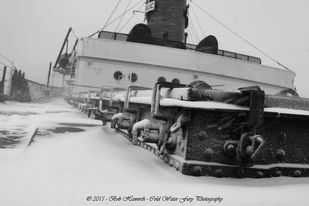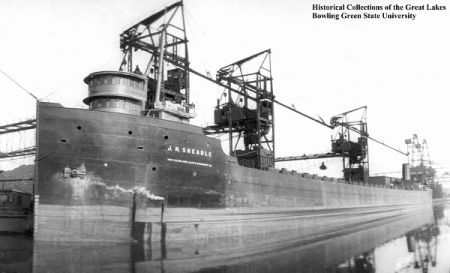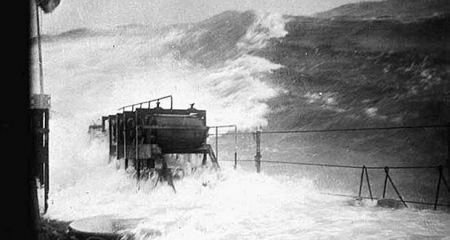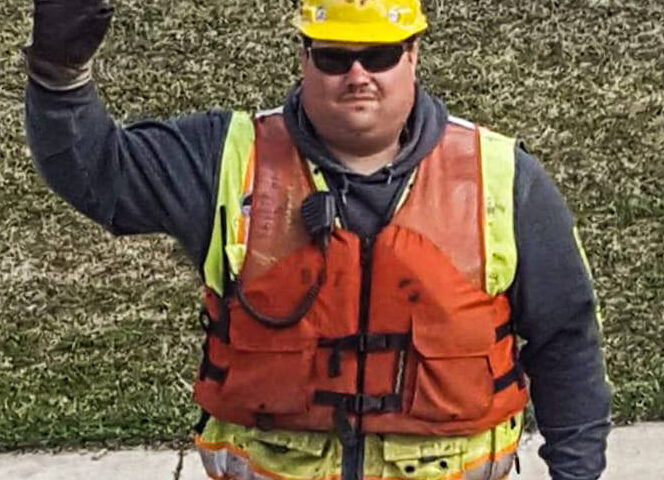This article is printed with permission and was written by Bob Haworth from the memoir notes of Captain S. A. Lyons detailing the trip of the Great Lakes freighter, SS Sheadle, from Nov. 7-10, 1913 during a “white hurricane.” Haworth is a writer, photographer, musician, and an AB Seaman on the freighter, Joseph L. Block. For more information on the storm that sank 12 freighters and wrecked 31, check out this website: https://www.lakesuperior.com/the-lake/great-lakes/frozen-fury-the-1913-white-hurricane/
For more information on Haworth, look for my article on him in the coming weeks.
“It was near 2:00 a.m. on Nov. 8, 1913 when the 530-foot steel steamer, J. H. Sheadle captained by S. A. Lyons, passed downbound through Detour passage and entered Lake Huron with a load of grain from Fort William bound for Erie, Pennsylvania. The Sheadle had left the lakehead at 8:00 p.m. on Nov. 6 with the James Carruthers also loading out of Fort William for Midland, Ontario. While at Fort William, the captains aboard each vessel had talked and decided to run together down Lake Superior and the St. Marys River. Sometime on the morning of Nov. 8, the Hydrus, another steamer, fell in behind the Sheadle as she came out of the fog shrouding Whitefish Bay. The Hydrus was bound for Cleveland with a load of iron ore.

Just as she was making the turn at Sweets Point, the crew on the Sheadle observed the Carruthers taking on bunker fuel at the Pickands Mather fuel dock. She would throw her lines off, depart the dock, and turn around, heading out into Lake Huron ahead of the Sheadle. The Carruthers made a turn to the southeast on a course that would keep her south of Great Duck Island. As the Sheadle made her run out into the lake, she observed the Carruthers on her way to Georgian Bay. Capt. Lyons and his crew would be the last to see the Carruthers. [She floundered and sank during the storm that saw waves as high as 35’ and wind gusts that reached 90 mph.]
Once out into Lake Huron, the Sheadle had a somewhat smooth run until she was just off Presque Isle when it began to snow. At times the snow would be intermittent and provide enough sight to see Middle Island. By 8:35 a.m. the Sheadle made Thunder Bay Island. All seemed okay, but that would change. By 11:30 a.m. the wind was blowing straight out of the north and the seas were following suit. The Sheadle was working well, but it was apparent the seas had to be kept square behind her stern. Course was changed to south by east in hopes of keeping the seas from breaking over her deck. The storm was raging and snow was blowing so hard that at times Capt. Lyons could not see the stern of his boat and had lost sight of the Hydrus trailing him about 5 to 10 miles. He would never see the Hydrus again. [She, like the Carruthers, was lost to the storm.]
Into the afternoon the seas increased and the wind was up to 75 mph. This made handling the fully loaded Sheadle a problem. The seas would board the vessel pushing the wheel (propeller) down into the waves and lifting it out as it traveled up her deck. The engineers were having a hard time keeping the necessary speed to navigate the boat. As the wheel would come out of the water, the engine would race due to the sudden loss of load on the wheel. One engineer would have to watch out the porthole and communicate with the other engineer who was on the throttle of the engine. Too much speed on the engine without a load could cause stress on the bearings and running gear and that alone was enough to cripple the vessel. The Sheadle would become so burdened with waves at times that her engine RPMs would be reduced from 75 to 35.
At 3:45 p.m., while struggling to make headway, a wave boarded her stern flooding the fantail and penetrating the aft cabin. Water rushed into the galley, washing food out of the refrigerator, smashing dishes, and knocking the galley crew to the deck. Windows were broken as well as the skylights in the officers’ dining room and the engine room. Vast amounts of water washed down into the engine room. The work boat located atop the boat deck and the Mate’s chadburn on the fantail were washed away. Capt. Lyons ordered the deck crew aft to help board up the windows and busted skylights. The crew carried shutters for the windows and clung to the rail as they made their way aft. They began putting shutters in place when another wave boarded the Sheadle and washed the shutters away. The men reached for whatever they could find to keep from being washed overboard. They attempted to make the dining room, but a third sea washed over and again they clung to anything they could find. They finally made it, and an Oiler stood at the door, opening it to let water out and closing it when a wave would breach the stern.

By 4:50 p.m. soundings being taken indicated the Sheadle was now abreast of Harbor Beach. The course was changed to due south, running the boat dead before the seas and wind. Down the lake the steamer wallowed into the evening hours. At 9:00 p.m. the soundings showed a water depth of 18 fathoms (108 feet). The Sheadle was running out of water due to reaching the southern end of the lake. Capt. Lyons peered through the blowing snow, looking for the Fort Gratiot Light. Running blind and thinking of the downbound steamers that could be anchored at the river entrance, he decided to turn around. He called the engine room telling them to secure everything that could move about and to have the plant ready to make full power when it came time to make the turn. The word spread throughout the boat and the crew hurried to tie down everything that wasn’t secured. At 10:00 p.m., he rang FULL AHEAD twice on the chadburn and the Wheelsman turned the Sheadle for east-northeast.
With all the power she could, she made the turn, rolling heavily. She came around and when the spray from the approaching sea began to hit the wheelhouse windows, they knew they had made the turn. The Sheadle was riding well, and her crew had every bit of confidence in her. The First Mate went aft to check the steering quadrant and chains. He phoned back stating that everything was in order, but due to the mass of green water on deck, he could not make his way forward. He gave it a try but returned to the aft cabin soaked and barely awake.

For the next six hours, the steamer traveled back up the lake heading northeast. Soundings were now showing 22 fathoms (132 feet). Sometime in the morning, one of the Wheelsmen made his way aft, securing some food for the forward end crew and returned with the Mate and the Bosun. Around 4:15 a.m. on Nov. 10, the captain decided to turn again. This time the vessel encountered extreme difficulty. The head sea acted as a buffer and the Sheadle’s speed was greatly reduced. These combinations caused her to stay in the trough longer than the first time. The crew found themselves with their feet off the deck and themselves in the air. The ship would be thrown down into the trough, then she’d roll back the other way over the passing wave. Her crew and her belongings were thrown around at will. One wave would hit her and before it cleared her deck, a second one, larger than the first, would hit and a third would follow suit.
Capt. Lyons was worried that her steering gear would give out from the beating the rudder was taking, but eventually she made the turn and set a southwesterly course. Speed was reduced to 55 turns from full speed. The Sheadle reached the location from which they had come six hours earlier in two hours’ time. At 6:30 a.m. the snow was still blowing heavily, and the soundings were getting shallow. The captain called the engine room and told them to make ready for another turn. With the blinding snow, he could not make out any vessels or the Fort Gratiot Light. The Sheadle made her third turn at 6:45 a.m. At this time the sea had decreased, and the wind was now out of the northwest with the venerable steamer heading right into it. The wind was still blowing at 70 mph. With the blowing snow, the captain had kept the whistle blowing, a futile attempt at safety as the men in the pilothouse couldn’t hear it.

By 8:30 a.m. the snow had cleared up and the wind had begun to die down. It was then that the Sheadle made her fourth and final turn, settling on a heading to the southwest. After turning, she passed the overturned hull of a vessel about 1,000 feet off her port side. Flotsam was strewn about the wreck, floating to the south of its position. By now the seas had calmed down. Capt. Lyons spotted the Fort Gratiot Lightship about three miles off its position. The snow started again and the Sheadle reduced her speed, dropped anchor, and waited for better visibility to enter the river.
At noon, the anchor was hauled up and the Sheadle entered the river. By 7:00 p.m. she had passed Detroit and for the first time since passing Thunder Bay Island the crew could enjoy a meal in the wet, tattered galley. She stopped at Smith’s Coal Dock on Nov. 11 to fuel and take on provisions but was underway at 9:00 a.m. With ice on her rigging and snow still clinging to her hull, decks, and cabin work, she steamed into Erie, at 11:10 a.m. on Nov. 12.”
Thank you, Bob, for this story and for reminding us how dangerous the lakes can be anytime of the year but especially in November. Today we remember the Edmund Fitzgerald and the men aboard her who never made it home. It’s been 46 years since Lake Superior claimed all of them.
- Saying Goodbye to Charlie Brown - July 2, 2024
- Mike Lynn Says Farewell to Lynn Auto Parts, Inc. - November 25, 2022
- Sharon Kennedy:The Hay Fields of Tony Jarvie - August 11, 2022




Very interesting article Sharon as are all of your publications.